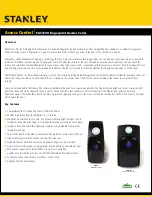
TST-020 PT-AIR
– REV. 2017-246
Page 8 of 14
PAD SYSTEM TESTS
Note: The following assumes operator has access to suitable plugs, a ball valve with vacuum
gauge, and additional hose and adapter fittings for connecting the ball valve to the lifter’s vacuum
lines and fittings.
If it was determined that the vacuum generating system does not leak, or if any existing leaks in the
vacuum generating system have been repaired, proceed with the following:
Isolate the vacuum pads, fittings and vacuum line sections until the leak point can be located:
Lifter models with shut-off valves on all vacuum pads:
1) Close the shut-off valve to all the vacuum pads.
Two shut-off valves are attached to
the central manifold and the
remaining shut-off valves are located
in the pad lines to the individual
vacuum pads. (See
FIGURE 6.)
2) Repeat the vacuum test.
If the vacuum level of the lifter’s
vacuum gauge holds steady and
does not drop: The vacuum pad
system does not leak between
the vacuum filter and the shut-off
valves.
Proceed to step 3.
If the vacuum level of the ball valve’s vacuum gauge starts and continues to drop: A leak
does exist between the vacuum filter and the shut-off valves.
o
Examine the hoses, hose connections and fittings for any indication of loose
connections, cuts or abrasions, cracked or damaged fittings. If there is no visible
damage, use the ball valve with gauge and/or cap plugs to cap off individual fittings and
lines to determine where the leak is.
See
step 6
for more information on this process.
For lifter models without shut-off valves or if it was
determined that there is no leak up to the shut-off
valves:
3) Remove the pad fitting from each of the vacuum pads.
Cap off the pad fittings.
See circled detail in
FIGURE 7
.
4) Open the air supply valve and apply the lifter.
FIGURE 6
FIGURE 7
Содержание POWER TILT
Страница 2: ...TST 020 PT AIR REV 2017 246 ...



































